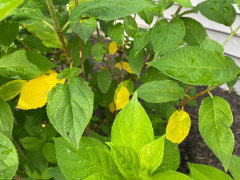The Hydrangea Leaves Turning Yellow PDFs
How Hydrangea Leaves Turning Yellow can Save You Time, Stress, and Money.
Table of ContentsA Biased View of Hydrangea Leaves Turning YellowThe 7-Second Trick For Hydrangea Leaves Turning YellowThe Main Principles Of Hydrangea Leaves Turning Yellow Some Of Hydrangea Leaves Turning YellowThe Buzz on Hydrangea Leaves Turning Yellow
These issues are very easy to identify and repair if you take steps before root rot embed in. A wetness meter can aid guide you to the very best approach of adjustment. Large leaves usually look sagging during the mid-day warm. When they stop working to perk up at night or still look shrivelled in the morning, your plant can be overwatered.Eliminate the plant from the dirt and prune out any kind of roots that aren't white and turgid (plump). Do not attempt to deal with the problem by sprinkling exceedingly.
Photosynthesis, as most of us know, is vital for plant survival, so chlorosis needs to be dealt with quickly. While chlorosis can be triggered by other nutrient shortages, it is most commonly an iron deficiency. In the complying with section you will discover just how to recognise whether your plant has an iron shortage or another thing.
Initially shows up on the older fallen leaves, but the fallen leave capillaries remain environment-friendly. A magnesium deficiency shows up initially on old fallen leaves and ought to not be perplexed with an iron shortage [Image: izzzy71/ Shutterstock. com] While there is usually enough iron in natural dirt, hydrangeas often have a hard time to soak up enough of it.
Getting The Hydrangea Leaves Turning Yellow To Work
The most effective means to stop iron deficiency-chlorosis in hydrangeas is to grow them in suitable ericaceous or acidic dirt. When planting in a bed, mix in some peat or reduced-peat ericaceous garden compost and examine the p, H worth yearly. This is needed since the compost blend around the plants will affect the p, H worth of the soil over time and the p, H value may rise once more.
It is just made use of on a business range, where a long term iron deficiency would certainly imply considerable return losses. The unique fertilizers for this are typically expensive and require to be used in very precise dosages to stay clear of damages to the leaves. Foliar fertilisation is only reliable for a short duration and needs to be used regularly or supplemented by normal iron fertilisation.
September is the very best time of year to do something regarding those hydrangeas. Their fallen leaves are transforming yellow, the flowers have faded, and their gangly appearance is making you crazy. Starting with the existing blossoms, currently is the moment to reduce them for dried out arrangements. If you cut the huge flowers previously in the period, they will wilt.
Mophead, Lacecap and Oakleaf hydrangeas bloom on old timber. Do not trim Mophead, Lacecaps and Oakleaf hydrangeas to the ground, as you will get rid of the stems that are ready to grow next springtime.
Hydrangea Leaves Turning Yellow - Questions
That way you will not be eliminating also several of next year's blossom buds. Prune out as much dead wood as you can find. You can reduce nonessential to the ground. try this web-site If the hedge is obtaining bigger than you like, you can secure a third of the online wood while you remain in there.
We're right in the center of our late-blooming hydrangea period below, so I thought I would certainly share an idea for this certain kind of hydrangea that I found truly fascinating. A great deal of individuals have a comparable concern with their panicle hydrangeas where they begin to see the leaves transforming yellow and leaving at different parts of the season and it can be quite remarkable and quite concerning due to the fact that it can take place really rapidly on a hedge that feels Go Here like it's or else actually healthy.

Where we live in zone 6, they're fairly simple to have success with and they're truly popular in our location, which is terrific because that implies that there are visit this site right here hydrangeas practically everywhere at this time of year. When you see your hydrangea leaves beginning to transform yellow, you may believe that your plant is passing away or being mistreated in some method, yet in truth, the reverse is true.
Everything about Hydrangea Leaves Turning Yellow
If you really desire to maximize blooms, a (the center number) will actually help raise the number and size of your blooms. You need to see the variety of newly-yellowed fallen leaves reduce pretty promptly as quickly as you offer your hydrangea the food it requires. Hydrangea Leaves Turning Yellow. The bright side is that if you do absolutely nothing, the plant will still be fine, it will just have a couple of much less fallen leaves
Courtenay is the author of the book The Cleansing Ninja and has actually been featured in various magazines including Country Sampler Farmhouse Design, Better Houses and Gardens, Parents Magazine, Real Simple, and Our Residences.
Water logged soil robs the roots of oxygen, leading to root rot and yellow fallen leaves. On the other hand, underwatering or dehydration causes the plant to wilt and its foliage to yellow. Keeping a regular watering timetable and guaranteeing correct drainage through water drainage openings or layers can aid stop these issues.
Regularly check the dirt acidity, and change as required to maintain the optimal p, H degree for hydrangeas. With correct care and maintenance, hydrangeas can thrive and maintain their vibrant, colorful leaves. Hydrangea leaves transforming yellow is a common problem that can be credited to various elements. Among the main reasons is improper watering, as hydrangeas require constantly moist soil to grow.
Hydrangea Leaves Turning Yellow - Questions
